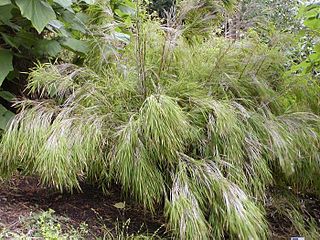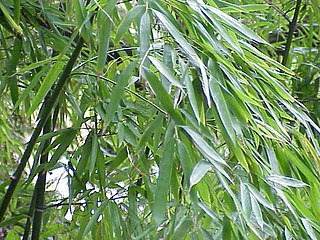
The bamboos are evergreen perennial flowering plants in the subfamily Bambusoideae of the grass family Poaceae. The word "bamboo" comes from the Dutch or Portuguese languages, which probably borrowed it from Malay.

The Mexican weeping bamboo, Otatea acuminata, is a clumping bamboo native to central and southern Mexico and Central America.

Guadua is a Neotropical genus of thorny, clumping bamboo in the grass family, ranging from moderate to very large species.

Phyllostachys aureosulcata, the yellow groove bamboo, is a species of bamboo native to the Zhejiang Province of China. It is a running bamboo with a distinctive yellow stripe in the culm groove that is often grown as an ornamental.

Bambusa vulgaris, common bamboo, is an open-clump type bamboo species. It is native to Indochina and to the province of Yunnan in southern China, but it has been widely cultivated in many other places and has become naturalized in several. Among bamboo species, it is one of the largest and most easily recognized.

Schizostachyum glaucifolium, common name Polynesian ʻohe, is a species of bamboo.

Bamboo blossom is a natural phenomenon in which the bamboos in a location blossom and become hung with bamboo seeds. This is commonly found in China, Myanmar and India.
Arundinaria appalachiana, commonly known as hill cane, is a woody bamboo native to the Appalachian Mountains in the southeastern United States. The plant was elevated to the species level in 2006 based on new morphological and genetic information and was previously treated as a variety of Arundinaria tecta. As a relatively small member of its genus, it usually only attains heights of 0.5 to 1.0 metre with an either dense or diffuse habit. It is one of only three temperate species of bamboo native to North America. Hill cane is common on dry to mesic sites on upland slopes, bluffs and ridges in oak-hickory forests. In contrast to its sympatric relatives, Arundinaria gigantea typically appears along perennial streams, while A. tecta is found in swamps and other very wet areas.

Bambusa tulda, or Indian timber bamboo, is considered to be one of the most useful of bamboo species. It is native to the Indian subcontinent, Indochina, Tibet, and Yunnan, and naturalized in Iraq, Puerto Rico, and parts of South America.
Phyllostachys atrovaginata is a running bamboo with strongly tapered, stiff, upright culms. It may reveal a fragrant scent during warm weather or when vigorously rubbed. The common name of "incense bamboo" comes from the unique aroma. Its culms grow large in diameter relative to height. Maximum height can reach 10 m (33 ft) with a maximum culm diameter of 7.0 cm (2.7 in). This bamboo grows in areas ranging from subtropical to temperate and tolerates winter temperatures down to -23 °C (-10 °F), being a more cold-hardy bamboo. Like water bamboo, the rhizomes and roots of this species also have air canals as an adaptation for living in wet soil. The specific epithet atrovaginata or "dark-sheathed" is inspired from the dark green and deep red wine colors of the culm sheaths. P. atrovaginata has formerly been called Phyllostachys congesta.

Phyllostachys rubromarginata, the reddish bamboo or red margin bamboo, is a species of Phyllostachys bamboo, native to Central China, specifically Guangxi and Guizhou.

Bambusa lako, known as Timor black bamboo, is a large species of bamboo originating from the island of Timor; its black culms may reach 21 m (69 ft) in height. A 2000 molecular study places it as closely related to the similar Indonesian species Gigantochloa atroviolacea, from which it was separated in 1997; it may soon be placed in that genus. Bambusa lako can only be grown in climates that are mostly frost free.

Phyllostachys parvifolia is a running bamboo with thick culms that grow tall for a bamboo that endures cold weather.

Dendrocalamus strictus is a bamboo species belonging to the Dendrocalamus genus. The culms (stems) are often solid. Common names include male bamboo, solid bamboo, and Calcutta bamboo.

Phyllostachys edulis, the moso bamboo, or tortoise-shell bamboo, or mao zhu, is a temperate species of giant timber bamboo native to China and Taiwan and naturalised elsewhere, including Japan where it is widely distributed south of Hokkaido. The edulis part of the Latin name refers to its edible shoots. This bamboo can reach heights of up to 28 m (92 ft). This particular species of bamboo is the most common species used in the bamboo textile industry of China, for the production of rayon.

Phyllostachys aurea is a bamboo species of the 'running bamboo' type, belonging to the diverse Bambuseae tribe. It is native to Fujian and Zhejiang in China. It is commonly known by the names fishpole bamboo, golden bamboo, monk's belly bamboo, and fairyland bamboo (Australia).

Bambusa bambos, the giant thorny bamboo, Indian thorny bamboo, spiny bamboo, or thorny bamboo, is a species of clumping bamboo native to southern Asia. It is also naturalized in Seychelles, Central America, West Indies, Java, Malaysia, Maluku, and the Philippines.

Pseudosasa japonica, common names arrow bamboo and Japanese arrow bamboo, is a species of bamboo.

Phyllostachys bambusoides, commonly called madake, giant timber bamboo, or Japanese timber bamboo, is a species of flowering plant in the bamboo subfamily of the grass family Poaceae, native to China, and possibly also to Japan.

Dendrocalamus asper, also known as giant bamboo, or dragon bamboo, is a giant tropical, dense-clumping species native to Southeast Asia. Due to its common occurrence across Asia and its attractive features as well as ease of harvesting, this species has been introduced widely across Latin America and Africa. It is a sympodial or clumping bamboo that does not show lateral growth and therefore has no invasive properties.

















